Chemistry of Zircon and Its Implication on the Petrogenesis of Cretaceous Volcanic Rocks from the Southeastern Coast of Zhejiang Province, South China
Abstract
1. Introduction
2. Geological Setting and Sampling
3. Analytical Methods
3.1. Zircon U-Pb Isotope and Trace Element Analyses
3.2. Zircon Lu-Hf Isotope Analysis
3.3. Whole-Rock Major and Trace Element Analyses
4. Results
4.1. LA-ICP-MS U-Pb Zircon Ages
4.2. Zircon Trace Elements Composition and Lu-Hf Isotopes
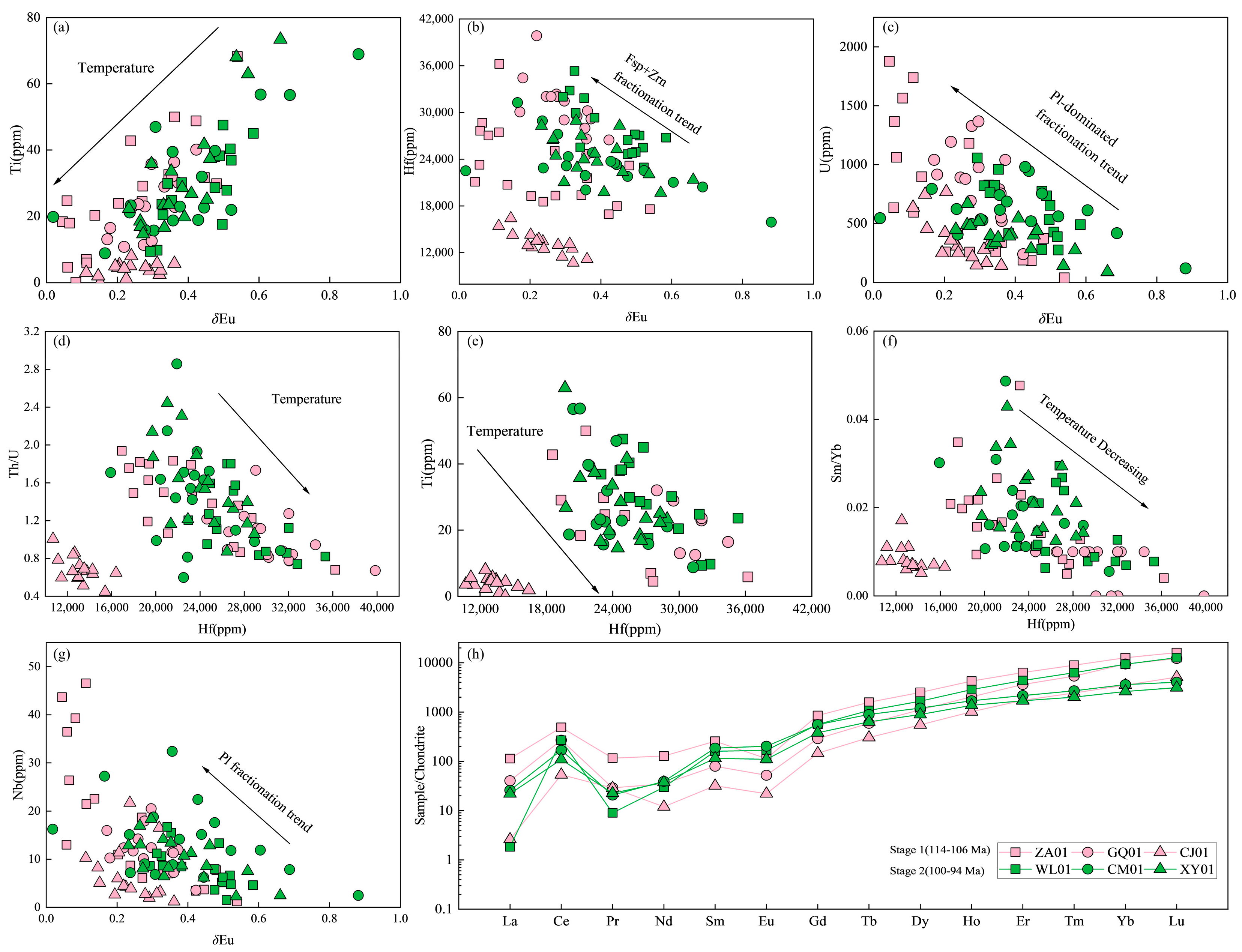
4.3. Whole-Rock Major and Trace Element Compositions
5. Discussion
5.1. Spatio-Temporal Distribution of Magmatism in Zhejiang-Fujian Coastal Region
5.2. Petrogenetic Insights from Integrated Whole-Rock and Zircon Chemistry
5.2.1. Fractional Crystallization
5.2.2. Magma Source
5.2.3. Partial Melting Conditions of the Crust
5.3. Origin and Evolution Model of the SE China Cretaceous Volcanic Rocks
6. Conclusions
Supplementary Materials
Author Contributions
Funding
Data Availability Statement
Acknowledgments
Conflicts of Interest
References
- Lapierre, H.; Jahn, B.M.; Charvet, J.; Yu, Y.W. Mesozoic felsic arc magmatism and continental olivine tholeiites in Zhejiang Province and their relationship with the tectonic activity in southeastern China. Tectonophysics 1997, 274, 321–338. [Google Scholar] [CrossRef]
- Zhou, X.M.; Li, W.X. Origin of Late Mesozoic igneous rocks in Southeastern China: Implications for lithosphere subduction and underplating of mafic magmas. Tectonophysics 2000, 326, 269–287. [Google Scholar] [CrossRef]
- Zhou, X.M.; Sun, T.; Shen, W.Z.; Shu, L.S.; Niu, Y.L. Petrogenesis of Mesozoic granitoids and volcanic rocks in South China: A response to tectonic evolution. Episodes 2006, 29, 26–33. [Google Scholar] [CrossRef]
- Liu, L.; Xu, X.S.; Xia, Y. Cretaceous Pacific plate movement beneath SE China: Evidence from episodic volcanism and related intrusions. Tectonophysics 2014, 614, 170–184. [Google Scholar] [CrossRef]
- Liu, L.; Xu, X.S.; Xia, Y. Asynchronizing paleo-Pacific slab rollback beneath SE China: Insights from the episodic Late Mesozoic volcanism. Gondwana Res. 2016, 37, 397–407. [Google Scholar] [CrossRef]
- Bachmann, O.; Huber, C. Silicic magma reservoirs in the Earth’s crust. Am. Mineral. 2016, 101, 2377–2404. [Google Scholar] [CrossRef]
- Ma, C.Q.; Liu, B.; Xue, Z.H.; Zou, B.W.; Huang, G.Z.; Lian, Q.C.; Gao, K.; Sun, Y.; Wang, L.X. Revealing the volcanic eruption process and magma channel system from the Changying intrusive body. Acta Petrol. Sin. 2024, 40, 1997–2018, (In Chinese with English abstract). [Google Scholar]
- Annen, C.; Blundy, J.D.; Sparks, R.S.J. The Genesis of Intermediate and Silicic Magmas in Deep Crustal Hot Zones. J. Petrol. 2006, 47, 505–539. [Google Scholar] [CrossRef]
- Cashman, K.V.; Sparks, R.S.J.; Blundy, J.D. Vertically extensive and unstable magmatic systems: A unified view of igneous processes. Science 2017, 355, eaag3055. [Google Scholar] [CrossRef]
- Bouvet de Maisonneuve, C.; Forni, F.; Bachmann, O. Magma reservoir evolution during the build up to and recovery from caldera-forming eruptions–A generalizable model? Earth Sci. Rev. 2021, 218, 103684. [Google Scholar] [CrossRef]
- Yan, L.L.; He, Z.Y. The constraints of magma supply on the evolution of siliceous volcanic magma systems. Acta Geol. Sin. 2022, 96, 1697–1710, (In Chinese with English abstract). [Google Scholar]
- Wang, Y.J.; Fan, W.M.; Zhang, G.W.; Zhang, Y.H. Phanerozoic tectonics of the South China Block: Key observations and controversies. Gondwana Res. 2013, 23, 1273–1305. [Google Scholar] [CrossRef]
- Gao, Q.; Ding, J.L.; Zhang, Y.Q.; Zhou, P.; Zeng, Z.J.; Li, Z.L. Is 95 Ma the turning point of the Late MesozoicMagmatie Evolution in South China?-Evidence from typical granitoids in Zhejiang and Fujian provinces. Geol. Rev. 2022, 68, 1760–1771, (In Chinese with English abstract). [Google Scholar]
- Zhao, L.; Guo, F.; Zhang, X.B.; Wang, G.Q. Cretaceous crustal melting records of tectonic transition from subduction to slab rollback of the Paleo-Pacific Plate in SE China. Lithos 2021, 384–385, 105985. [Google Scholar] [CrossRef]
- Keller, C.B.; Schoene, B.; Barboni, M.; Samperton, K.M.; Husson, J.M. Volcanic–plutonic parity and the differentiation of the continental crust. Nature 2015, 523, 301–307. [Google Scholar] [CrossRef] [PubMed]
- Li, Z.; Wang, X.C.; Wilde, S.A.; Liu, L.; Li, W.X.; Yang, X. Role of deep-Earth water cycling in the growth and evolution of continental crust: Constraints from Cretaceous magmatism in southeast China. Lithos 2018, 302–303, 126–141. [Google Scholar] [CrossRef]
- Zhou, D.; Sun, P.; Jiang, S.J.; Liu, X.; Wang, Q. Geochronology and geochemistry of Early Cretaceous high-silica granites in the Nan’ao Island, South China: Petrogenesis and implications for lithospheric extension. J. Asian Earth Sci. 2023, 245, 105558. [Google Scholar] [CrossRef]
- Wu, H.; Zhang, Y.; Wang, F.F.; Song, W.Y.; Bai, F.L.; Xue, B.Y.; Bi, S.P. Petrogenesis of Cretaceous volcanic rocks from islands off Fujian Province, East China Sea, and implications for episodic slab rollback of the paleo-Pacific plate. Gondwana Res. 2022, 103, 243–259. [Google Scholar] [CrossRef]
- Peng, H.W.; Fan, H.R.; Jiang, P.; Hu, H.L.; Lan, T.G. Two-stage rollbacks of the paleo-Pacific plate beneath the Cathaysia block during Cretaceous: Insights from A-type granites and volcanic rocks. Gondwana Res. 2021, 97, 158–175. [Google Scholar] [CrossRef]
- Wong, J.; Sun, M.; Xing, G.F.; Li, X.H.; Zhao, G.C.; Wong, K.; Yuan, C.; Xia, X.P.; Li, L.M.; Wu, F.Y. Geochemical and zircon U–Pb and Hf isotopic study of the Baijuhuajian metaluminous A-type granite: Extension at 125–100 Ma and its tectonic significance for South China. Lithos 2009, 112, 289–305. [Google Scholar] [CrossRef]
- Chu, P.L.; Jin, G.D.; Zhang, W.; Chen, R.; Fan, F.P.; Duan, Z.; Yu, M.G.; Zhao, X.l.; Li, L.M.; He, Z.Y. Geological characteristics and formation evolution of the Wangzhou Mountain volcanic eruption in Cangnan, Zhejiang Province. East. China Geol. 2022, 43, 460–473, (In Chinese with English abstract). [Google Scholar]
- Xu, X.S.; Zhao, K.; He, Z.Y.; Liu, L.; Hong, W.T. Cretaceous volcanic-plutonic magmatism in SE China and a genetic model. Lithos 2021, 402–403, 105728. [Google Scholar] [CrossRef]
- Charvet, J.; Shu, L.S.; Shi, Y.S.; Guo, L.; Faure, M. The building of south China: Collision of Yangzi and Cathaysia blocks, problems and tentative answers. J. Southeast Asian Earth Sci. 1996, 13, 223–235. [Google Scholar] [CrossRef]
- Xing, G.F.; Chen, R.; Yang, Z.L.; Zhou, Y.Z.; Li, L.M.; Jiang, Y.; Chen, Z.H. Characteristics and tectonic setting of Late Cretaceous volcanic magmatism in the coastal Southeast China. Acta Petrol. Sin. 2009, 25, 77–91, (In Chinese with English abstract). [Google Scholar]
- Zhang, G.Q.; Wang, Q.S.; Yu, Y.P.; Yang, C.; Xiao, J. Stratigraphic Age and Division of Volcanic Rock Regions in Eastern Zhejiang Province. J. Stratigr. 2012, 36, 641–652, (In Chinese with English abstract). [Google Scholar]
- Zhao, X.D. Report on the Research Results of Spatiotemporal Evolution of Mesozoic Volcanic Activity in Zhejiang Province; Geological Survey Institute of Zhejiang Province: Hangzhou, China, 2020. [Google Scholar]
- Liu, L.; Yang, J.H.; Kang, L.F.; Zhong, H.; Zhang, X.C. The long-lived transcrustal magmatic systems of Southeast China in response to paleo-Pacific plate subduction, recorded by the Cretaceous volcanic sequences in southeastern Zhejiang Province. Geol. Soc. Am. Bull. 2023, 135, 1091–1108. [Google Scholar] [CrossRef]
- Cai, Z.; Yu, Y. Subdivision and Correlation of the Upper Beds of the Cretaceous System in Zhejiang. J. Stratigr. 2001, 25, 259–266. [Google Scholar]
- Yu, M.; Xing, G.; Shen, J.; Chen, R.; Zhou, Y.; Kui, H.; Tao, K. Chronologic Study on Volcanic Rocksin the Mt.Yandangshan World Geopark. Acta Geol. Sin. 2006, 80, 1683–1690. [Google Scholar]
- Lu, C.; Gu, M.; Yu, Y.; Liang, H. Age of the Tangshang Formation in Different Basins of Eastern Zhejiang. J. Stratigr. 2006, 30, 81–86. [Google Scholar]
- Zheng, S.S.; Xu, X.S. Petrogenesis of Late Cretasceous volcanic-plutonie complex from Xiaoxiong caldera in East Zhejiang. Acta Petrol. Sin. 2021, 37, 3712–3734. [Google Scholar]
- Liu, Y.S.; Hu, Z.C.; Gao, S.; Günther, D.; Xu, J.; Gao, C.G.; Chen, H.H. In situ analysis of major and trace elements of anhydrous minerals by LA-ICP-MS without applying an internal standard. Chem. Geol. 2008, 257, 34–43. [Google Scholar] [CrossRef]
- Liu, Y.S.; Gao, S.; Hu, Z.C.; Gao, C.G.; Zong, K.Q.; Wang, D.B. Continental and Oceanic Crust Recycling-induced Melt-Peridotite Interactions in the Trans-North China Orogen: U-Pb Dating, Hf Isotopes and Trace Elements in Zircons from Mantle Xenoliths. J. Petrol. 2009, 51, 537–571. [Google Scholar] [CrossRef]
- Wiedenbeck, M.; AllÉ, P.; Corfu, F.; Griffin, W.L.; Meier, M.; Oberli, F.; Quadt, A.V.; Roddick, J.C.; Spiegel, W. Three natural zircon standards for U-Th-Pb, Lu-Hf, trace element and REE analyses. Geostand. Geoanal. Res. 1995, 19, 1–23. [Google Scholar] [CrossRef]
- Stacey, J.S.; Kramers, J.D. Approximation of terrestrial lead isotope evolution by a two-stage model. Earth Planet. Sci. Lett. 1975, 26, 207–221. [Google Scholar] [CrossRef]
- Ludwig, K.R. ISOPLOT 3.0: A Geochronological Toolkit for Microsoft Excel; Berkeley Geochronology Center Special Publication: Berkeley, CA, USA, 2003; pp. 1–70. [Google Scholar]
- Woodhead, J.; Hergt, J.; Shelley, M.; Eggins, S.; Kemp, R. Zircon Hf-isotope analysis with an excimer laser, depth profiling, ablation of complex geometries, and concomitant age estimation. Chem. Geol. 2004, 209, 121–135. [Google Scholar] [CrossRef]
- Segal, I.; Halicz, L.; Platzner, I.T. Accurate isotope ratio measurements of ytterbium by multiple collection inductively coupled plasma mass spectrometry applying erbium and hafnium in an improved double external normalization procedure. J. Anal. At. Spectrom. 2003, 18, 1217–1223. [Google Scholar] [CrossRef]
- Hu, Z.C.; Liu, Y.S.; Gao, S.; Liu, W.G.; Zhang, W.; Tong, X.R.; Lin, L.; Zong, K.Q.; Li, M.; Chen, H.H.; et al. Improved in situ Hf isotope ratio analysis of zircon using newly designed X skimmer cone and jet sample cone in combination with the addition of nitrogen by laser ablation multiple collector ICP-MS. J. Anal. At. Spectrom. 2012, 27, 1391–1399. [Google Scholar] [CrossRef]
- GB/T 14506.31-2019; Methods for Chemical Analysis of Silicate Rocks. Standards Press of China: Beijing, China, 2019.
- Hoskin, P.W.; Schaltegger, U. The Composition of Zircon and Igneous and Metamorphic Petrogenesis. Rev. Miner. Geochem. 2003, 53, 27–62. [Google Scholar] [CrossRef]
- Ferry, J.M.; Watson, E.B. New thermodynamic models and revised calibrations for the Ti-in-zircon and Zr-in-rutile thermometers. Contrib. Miner. Petrol. 2007, 154, 429–437. [Google Scholar] [CrossRef]
- Sun, S.S.; McDonough, W.F. Chemical and isotopic systematics of oceanic basalts: Implications for mantle composition and processes. Geol. Soc. Lond. Spec. Publ. 1989, 42, 313–345. [Google Scholar] [CrossRef]
- Griffin, W.L.; Pearson, N.J.; Belousova, E.; Jackson, S.E.; van Achterbergh, E.; O’Reilly, S.Y.; Shee, S.R. The Hf isotope composition of cratonic mantle: LAM-MC-ICPMS analysis of zircon megacrysts in kimberlites. Geochim. Cosmochim. Acta 2000, 64, 133–147. [Google Scholar] [CrossRef]
- Xu, X.S.; O’Reilly, S.Y.; Griffin, W.L.; Wang, X.L.; Pearson, N.J.; He, Z.Y. The crust of Cathaysia: Age, assembly and reworking of two terranes. Precambrian Res. 2007, 158, 51–78. [Google Scholar] [CrossRef]
- Yan, L.L.; He, Z.Y.; Jahn, B.M.; Zhao, Z.D. Formation of the Yandangshan volcanic–plutonic complex (SE China) by melt extraction and crystal accumulation. Lithos 2016, 266–267, 287–308. [Google Scholar] [CrossRef]
- Wang, X.Y.; Xu, X.S.; Zhao, K. Petrogenesis of episodie Cretaceous volcanic-intrusive rocks in the Kuocangshan-Yandangshan calderas in the eastern Zhejiang. Bull. Mineral. Petrol. Geochem. 2023, 42, 1062–1077+1964, (In Chinese with English abstract). [Google Scholar]
- Middlemost, E.A.K. Naming materials in the magma/igneous rock system. Earth Sci. Rev. 1994, 37, 215–224. [Google Scholar] [CrossRef]
- Gill, J.B. Organic Andesites and Plate Tectonics; Springer: Berlin, Germany, 1981. [Google Scholar]
- Maniar, P.D.; Piccoli, P.M. Tectonic discrimination of granitoids. Geol. Soc. Am. Bull. 1989, 101, 635–643. [Google Scholar] [CrossRef]
- Wright, J.B. A simple alkalinity ratio and its application to questions of non-orogenic granite genesis. Geol. Mag. 1969, 106, 370–384. [Google Scholar] [CrossRef]
- Rudnick, R.L.; Gao, S. Composition of the Continental Crust. In Treatise on Geochemistry; Holland, H.D., Turekian, K.K., Eds.; Elsevier: Amsterdam, The Netherlands, 2003; Volume 3, pp. 1–64. [Google Scholar]
- Xing, G.F.; Lu, Q.D.; Chen, R.; Zhang, Z.Y.; Nie, T.C.; Li, L.M.; Huang, J.L.; Lin, M. Comparing to the Yanshan Area in North China Study on the Ending Time of Late Mesozoie Teetonie Regime Transition in South China. Acta Geol. Sin. 2008, 82, 451–463, (In Chinese with English abstract). [Google Scholar]
- Mao, J.R.; Ye, H.M.; Li, Z.L.; Zhao, X.L.; Liu, K.; Li, J.Y.; Yutaka, T.; KEE, W.S. Research on Mesozoic Tectonic-Magmatic Activities in South China: Current Status and Prospects. Sci. Sin. Terrae 2014, 2593–2617, (In Chinese with English abstract). [Google Scholar]
- Guo, F.; Fan, W.M.; Li, C.W.; Zhao, L.; Li, H.X.; Yang, J.H. Multi-stage crust–mantle interaction in SE China: Temporal, thermal and compositional constraints from the Mesozoic felsic volcanic rocks in eastern Guangdong–Fujian provinces. Lithos 2012, 150, 62–84. [Google Scholar] [CrossRef]
- Chamberlain, K.J.; Wilson, C.J.N.; Wooden, J.L.; Charlier, B.L.A.; Ireland, T.R. New Perspectives on the Bishop Tuff from Zircon Textures, Ages and Trace Elements. J. Petrol. 2013, 55, 395–426. [Google Scholar] [CrossRef]
- Yan, L.L.; He, Z.Y.; Beier, C.; Klemd, R. Zircon trace element constrains on the link between volcanism and plutonism in SE China. Lithos 2018, 320–321, 28–34. [Google Scholar] [CrossRef]
- Medlin, C.C.; Jowitt, S.M.; Cas, R.A.F.; Smithies, R.H.; Kirkland, C.L.; Maas, R.A.; Raveggi, M.; Howard, H.M.; Wingate, M.T.D. Petrogenesis of the A-type, Mesoproterozoic Intra-caldera Rheomorphic Kathleen Ignimbrite and Comagmatic Rowland Suite Intrusions, West Musgrave Province, Central Australia: Products of Extreme Fractional Crystallization in a Failed Rift Setting. J. Petrol. 2015, 56, 493–525. [Google Scholar] [CrossRef]
- Chen, J.Y.; Yang, J.H.; Zhang, J.H.; Sun, J.F.; Zhu, Y.S.; Hartung, E. Generation of Cretaceous high-silica granite by complementary crystal accumulation and silicic melt extraction in the coastal region of southeastern China. GSA Bull. 2022, 134, 201–222. [Google Scholar] [CrossRef]
- Valenzuela, A.; Teodosio, D.; Christian, P.; Manuel, T.; Michael, A.; Pascual, E. Geochemistry and U–Pb dating of felsic volcanic rocks in the Riotinto–Nerva unit, Iberian Pyrite Belt, Spain: Crustal thinning, progressive crustal melting and massive sulphide genesis. J. Geol. Soc. 2011, 168, 717–732. [Google Scholar] [CrossRef]
- Soesoo, A. Fractional crystallization of mantle-derived melts as a mechanism for some I-type granite petrogenesis: An example from Lachlan Fold Belt, Australia. J. Geol. Soc. 2000, 157, 135–149. [Google Scholar] [CrossRef]
- Farner, M.J.; Lee, C.T.A.; Putirka, K.D. Mafic–felsic magma mixing limited by reactive processes: A case study of biotite-rich rinds on mafic enclaves. Earth Planet. Sci. Lett. 2014, 393, 49–59. [Google Scholar] [CrossRef]
- Chappell, B.W.; White, A.J.R.; Wyborn, D. The Importance of Residual Source Material (Restite) in Granite Petrogenesis. J. Petrol. 1987, 28, 1111–1138. [Google Scholar] [CrossRef]
- Chen, J.F.; Guo, X.S.; Tonga, F.; Zhou, T.X. Nd Isotopic Model Agesimplications of the Growth of the Continental Crust of Southeastern China. J. Nanjing Univ. (Nat. Sci.) 1999, 35, 83–92, (In Chinese with English abstract). [Google Scholar]
- He, Z.Y.; Xu, X.S. Petrogenesis of the Late Yanshanian mantle-derived intrusions in southeastern China: Response to the geodynamics of paleo-Pacific plate subduction. Chem. Geol. 2012, 328, 208–221. [Google Scholar] [CrossRef]
- Qiu, J.S.; Liu, L.; Li, Z. Zircon U-Pb geochronology and Sr Nd Hf isotope geochemistry of Wanghaigang quartz syenite in Huangyan, Zhejiang Province, and their constraints on rock genesis. Acta Petrol. Sin. 2011, 27, 1557–1572, (In Chinese with English abstract). [Google Scholar]
- Liu, L.; Qiu, J.S.; Yang, Z.L. The genesis of the Maoliling pluton in Linhai, Zhejiang Province: Chronology, geochemistry, and Sr Nd Hf isotope constraints. Acta Petrol. Sin. 2013, 29, 4069–4086, (In Chinese with English abstract). [Google Scholar]
- Tang, M.; Ji, W.Q.; Chu, X.; Wu, A.B.; Chen, C. Reconstructing crustal thickness evolution from europium anomalies in detrital zircons. Geology 2020, 49, 76–80. [Google Scholar] [CrossRef]
- Zheng, Y.F.; Wu, R.X.; Wu, Y.B.; Zhang, S.B.; Yuan, H.L.; Wu, F.Y. Rift melting of juvenile arc-derived crust: Geochemical evidence from Neoproterozoic volcanic and granitic rocks in the Jiangnan Orogen, South China. Precambrian Res. 2008, 163, 351–383. [Google Scholar] [CrossRef]
- Zheng, Y.F.; Gao, P. The production of granitic magmas through crustal anatexis at convergent plate boundaries. Lithos 2021, 402–403, 106232. [Google Scholar] [CrossRef]
- Qiu, J.S.; Xu, J.S.; Jiang, S.Y. Deep subduction of the crust and genesis of potassium rich volcanic rocks. Earth Sci. Front. 2003, 10, 191–200, (In Chinese with English abstract). [Google Scholar]
- Huppert, H.E.; Sparks, R.S.J. The Generation of Granitic Magmas by Intrusion of Basalt into Continental Crust. J. Petrol. 1988, 29, 599–624. [Google Scholar] [CrossRef]
- Shan, Q.; Niu, H.C.; Yu, X.Y.; Zeng, Q.S. Geochemistry, magmatic genesis, and tectonic background of Late Paleozoic high potassium and high silicon fused tuff in the southern margin of Altay, northern Xinjiang. Acta Petrol. Sin. 2007, 23, 1721–1729, (In Chinese with English abstract). [Google Scholar]
- Chappell, B.W.; White, A.J.R. Two contrasting granite types: 25 years later. Aust. J. Earth Sci. 2001, 48, 489–499. [Google Scholar] [CrossRef]
- McDonough, W.F.; Sun, S.S. The composition of the Earth. Chem. Geol. 1995, 67, 1050–1056. [Google Scholar] [CrossRef]
- Barth, M.G.; McDonough, W.F.; Rudnick, R.L. Tracking the budget of Nb and Ta in the continental crust. Chem. Geol. 2000, 165, 197–213. [Google Scholar] [CrossRef]
- Bea, F. The sources of energy for crustal melting and the geochemistry of heat-producing elements. Lithos 2012, 153, 278–291. [Google Scholar] [CrossRef]
- Annen, C.; Sparks, R.S.J. Effects of repetitive emplacement of basaltic intrusions on thermal evolution and melt generation in the crust. Earth Planet. Sci. Lett. 2002, 203, 937–955. [Google Scholar] [CrossRef]
- Petford, N.; Gallagher, K. Partial melting of mafic (amphibolitic) lower crust by periodic influx of basaltic magma. Earth Planet. Sci. Lett. 2001, 193, 483–499. [Google Scholar] [CrossRef]
- Xu, X.S.; Huang, Z.C.; Jiang, D.S.; Zeng, G.; Dai, L.Q. Remnants and fragments of the subducted paleo-Pacific plate: Constraints from geochemistry and geophysics. Sci. China Earth Sci. 2024, 67, 3041–3061. [Google Scholar] [CrossRef]
- Karakas, O.; Dufek, J.; Mangan, M.T.; Wright, H.M.; Bachmann, O. Thermal and petrologic constraints on lower crustal melt accumulation under the Salton Sea Geothermal Field. Earth Planet. Sci. Lett. 2017, 467, 10–17. [Google Scholar] [CrossRef]
- Barboza, S.A.; Bergantz, G.W. Metamorphism and Anatexis in the Mafic Complex Contact Aureole, Ivrea Zone, Northern Italy. J. Petrol. 2000, 41, 1307–1327. [Google Scholar] [CrossRef]
- Greene, A.R.; DeBari, S.M.; Kelemen, P.B.; Blusztajn, J.; Clift, P.D. A Detailed Geochemical Study of Island Arc Crust: The Talkeetna Arc Section, South–Central Alaska. J. Petrol. 2006, 47, 1051–1093. [Google Scholar] [CrossRef]
- Collins, W.J.; Huang, H.Q.; Jiang, X.Y. Water-fluxed crustal melting produces Cordilleran batholiths. Geology 2016, 44, 143–146. [Google Scholar] [CrossRef]
- Zheng, Y.F.; Chen, R.X. Regional metamorphism at extreme conditions: Implications for orogeny at convergent plate margins. J. Asian Earth Sci. 2017, 145, 46–73. [Google Scholar] [CrossRef]
- Baier, J.; Audétat, A.; Keppler, H. The origin of the negative niobium tantalum anomaly in subduction zone magmas. Earth Planet. Sci. Lett. 2008, 267, 290–300. [Google Scholar] [CrossRef]
- Grimes, C.B.; Wooden, J.L.; Cheadle, M.J.; John, B.E. “Fingerprinting” tectono-magmatic provenance using trace elements in igneous zircon. Contrib. Miner. Petrol. 2015, 170, 46. [Google Scholar]
- McKay, M.P.; Jackson, W.T., Jr.; Hessler, A.M. Tectonic stress regime recorded by zircon Th/U. Gondwana Res. 2018, 57, 1–9. [Google Scholar] [CrossRef]
- Chen, C.H.; Lee, C.Y.; Lu, H.Y.; Hsieh, P.S. Generation of Late Cretaceous silicic rocks in SE China: Age, major element and numerical simulation constraints. J. Asian Earth Sci. 2008, 31, 479–498. [Google Scholar] [CrossRef]
- Li, J.H.; Zhang, Y.Q.; Dong, S.W.; Johnston, S.T. Cretaceous tectonic evolution of South China: A preliminary synthesis. Earth Sci. Rev. 2014, 134, 98–136. [Google Scholar] [CrossRef]
- Watson, E.B.; Harrison, T.M. Zircon saturation revisited: Temperature and composition effects in a variety of crustal magma types. Earth Planet. Sci. Lett. 1983, 64, 295–304. [Google Scholar] [CrossRef]
- Bachmann, O.; Bergantz, G.W. Rhyolites and their Source Mushes across Tectonic Settings. J. Petrol. 2008, 49, 2277–2285. [Google Scholar]
- Bachmann, O.; Bergantz, G.W. On the Origin of Crystal-poor Rhyolites: Extracted from Batholithic Crystal Mushes. J. Petrol. 2004, 45, 1565–1582. [Google Scholar]
- Lipman, P.W. Subsidence of ash-flow calderas: Relation to caldera size and magma-chamber geometry. Bull. Volcanol. 1997, 59, 198–218. [Google Scholar]
- Wallrich, B.M.; Miller, C.F.; Gualda, G.A.R.; Miller, J.S.; Hinz, N.H.; Faulds, J.E. Volcano-pluton connection: Perspectives on material and process linkages, Searchlight pluton and Highland Range volcanic sequence, Nevada, USA. Earth Sci. Rev. 2023, 238, 104361. [Google Scholar]
- Drabon, N.; Kirkpatrick, H.M.; Byerly, G.R.; Wooden, J.L. Trace elements in zircon record changing magmatic processes and the multi-stage build-up of Archean proto-continental crust. Geochim. Cosmochim. Acta 2024, 373, 136–150. [Google Scholar] [CrossRef]
- Trail, D.; Bruce Watson, E.; Tailby, N.D. Ce and Eu anomalies in zircon as proxies for the oxidation state of magmas. Geochim. Cosmochim. Acta 2012, 97, 70–87. [Google Scholar] [CrossRef]
- Liu, L.; Xu, X.; Zou, H.B. Episodic eruptions of the Late Mesozoic volcanic sequences in southeastern Zhejiang, SE China: Petrogenesis and implications for the geodynamics of paleo-Pacific subduction. Lithos 2012, 154, 166–180. [Google Scholar] [CrossRef]
- Li, S.Z.; Suo, Y.H.; Li, X.Y.; Zhou, J.; Santosh, M.; Wang, P.C.; Wang, G.Z.; Guo, L.L.; Yu, S.Y.; Lan, H.Y.; et al. Mesozoic tectono-magmatic response in the East Asian ocean-continent connection zone to subduction of the Paleo-Pacific Plate. Earth Sci. Rev. 2019, 192, 91–137. [Google Scholar] [CrossRef]
- Klimetz, M.P. Speculations on the Mesozoic Plate tectonic evolution of eastern China. Tectonics 1983, 2, 139–166. [Google Scholar] [CrossRef]
- Bryan, S. Silicic Large Igneous Provinces. Episodes 2007, 30, 20–31. [Google Scholar] [CrossRef]
- Hildreth, W.; Moorbath, S. Crustal contributions to arc magmatism in the Andes of Central Chile. Contrib. Miner. Petrol. 1988, 98, 455–489. [Google Scholar] [CrossRef]
- Dufek, J.; Bergantz, G.W. Lower Crustal Magma Genesis and Preservation: A Stochastic Framework for the Evaluation of Basalt–Crust Interaction. J. Petrol. 2005, 46, 2167–2195. [Google Scholar] [CrossRef]
- Deering, C.D.; Gravley, D.M.; Vogel, T.A.; Cole, J.W.; Leonard, G.S. Origins of cold-wet-oxidizing to hot-dry-reducing rhyolite magma cycles and distribution in the Taupo Volcanic Zone, New Zealand. Contrib. Miner. Petrol. 2010, 160, 609–629. [Google Scholar] [CrossRef]
- Tian, L.; Sun, D.Y.; Gou, J.; Jiang, S.; Feng, Z.; Zhang, D.; Hao, Y.J. Petrogenesis of the Newly Discovered Early Cretaceous Peralkaline Granitic Dikes in Baerzhe Area of Jarud Banner, Inner Mongolia: Implications for Deciphering Magma Evolution. Minerals 2022, 12, 1532. [Google Scholar] [CrossRef]
- Miller, C.F.; McDowell, S.M.; Mapes, R.W. Hot and cold granites? Implications of zircon saturation temperatures and preservation of inheritance. Geology 2003, 31, 529–532. [Google Scholar] [CrossRef]
- Brynton, W.V. Geochemistry of the rare earth elements: Meteorite studies. Rare Earth Elem. Geochem. 1984, 2, 63–114. [Google Scholar]
- Liu, L.; Qiu, J.S.; Zhao, J.L. A hybrid origin for two Cretaceous monzonitic plutons in eastern Zhejiang Province, Southeast China: Geochronological, geochemical, and Sr–Nd–Hf isotopic evidence. J. Asian Earth Sci. 2016, 115, 183–203. [Google Scholar] [CrossRef]
- Liu, Q.; Yu, J.H.; Wang, Q.; Su, B.; Zhou, M.F.; Xu, H.; Cui, X. Ages and geochemistry of granites in the Pingtan–Dongshan Metamorphic Belt, Coastal South China: New constraints on Late Mesozoic magmatic evolution. Lithos 2012, 150, 268–286. [Google Scholar] [CrossRef]
- Martin, H.; Bonin, B.; Capdevila, R.; Jahn, B.M.; Lameyre, J.; Wang, Y. The Kuiqi peralkaline granitic complex (SE China): Petrology and geochemistry. J. Petrol. 1994, 35, 983–1015. [Google Scholar] [CrossRef]
- Qiu, J.S.; Xiao, E.; Hu, J.; Xu, X.S.; Jiang, S.Y.; Li, Z. Petrogenesis of highly fractionated Itype granites in the coastal area of northeastern Fujian Province: Constraints from zircon U-Pb geochronology, geochemistry and Nd-Hf isotopes. Acta Petrol. Sin. 2008, 24, 2468–2484, (In Chinese with English abstract). [Google Scholar]
- Qiu, J.S.; Wang, D.Z.; Kanisawa, S.; Mcinnes, B.I.A. Geochemistry and petrogenesis of aluminous A-type granites in the coastal area of Fujian Province. Geochimica 2000, 29, 313–321, (In Chinese with English abstract). [Google Scholar]
- Qiu, J.S.; Wang, D.Z.; Mcinnes, B.I.A. Geochemistry and petrogenesis of the I- and Atype composite granite masses in the coastal area of Zhejiang and Fujian province. Acta Petrol. Sin. 1999, 15, 237–246, (In Chinese with English abstract). [Google Scholar]
- Qin, S.C.; Fan, W.M.; Guo, F.; Li, C.W.; Gao, X.F. Petrogenesis of Late Mesozoic diabase dikes in Zhejiang-Fujian provinces Constraints from Ar-Ar dating and geochemistry. Acta Petrol. Sin. 2010, 26, 3295–3306. [Google Scholar]
- Xu, X.; Dong, C.; Li, W.; Zhou, X. Late Mesozoic intrusive complexes in the coastal area of Fujian, SE China: The significance of the gabbro-diorite–granite association. Lithos 1999, 46, 299–315. [Google Scholar] [CrossRef]
- Yang, J.; Zhao, Z.; Hou, Q.; Niu, Y.; Mo, X.; Sheng, D.; Wang, L. Petrogenesis of Cretaceous (133–84 Ma) intermediate dykes and host granites in southeastern China: Implications for lithospheric extension, continental crustal growth, and geodynamics of Palaeo-Pacific subduction. Lithos 2018, 296–299, 195–211. [Google Scholar] [CrossRef]
- Zhao, J.H.; Hu, R.; Zhou, M.F.; Liu, S. Elemental and Sr–Nd–Pb isotopic geochemistry of Mesozoic mafic intrusions in southern Fujian Province, SE China: Implications for lithospheric mantle evolution. Geol. Mag. 2007, 144, 937–952. [Google Scholar]
- Zhao, J.H. Chronology and Geochemistry of Mafic Rocks from Fujian Province: Implications for the Mantle Evolution of SE China since Late Mesozoic. Ph.D. Thesis, Institute of Geochemistry of Chinese Academy of Sciences, Guiyang, China, 2004; pp. 1–107, (In Chinese with English abstract). [Google Scholar]
- Zhao, X.; Jiang, Y.; Xing, G.; Yu, M.; Mao, J.; Yu, S. Newly discovered Late Cretaceous adakites in South Fujian Province: Implications for the late Mesozoic tectonic evolution of Southeast China. Isl. Arc 2018, 27, e12236. [Google Scholar] [CrossRef]
- Zhao, X.; Yu, S.; Mao, J.; Liu, K.; Yu, M.; Jiang, Y.; Chen, Z.; Hou, K.; Peng, Y. Compression between microcontinents in the Cathaysian Block during the early Yanshanian: Petrogenesis of the Tangquan pluton in Southwest Fujian Province, Southeast China. Geol. J. 2017, 52, 970–991. [Google Scholar] [CrossRef]
- Zhou, J.C.; Chen, R. Geochemistry of late Mesozoic interaction between crust and mantle in southeastern Fujian Province. Geochimica 2001, 30, 547–558. [Google Scholar]
- Zhou, X.; Yu, J.H. Geochemistry of the granitoids in Mesozoic metamorphic belt of coastal Fujian Province. Geochimica 2001, 30, 282–292, (In Chinese with English abstract). [Google Scholar]
- Dong, C.W.; Zhang, D.R.; Xu, X.S.; Yan, Q.; Zhu, G.Q. SHRIMP U-Pb dating and lithogeochemistry of basic-intermediate dike swarms from Jinjiang, Fujian province. Acta Petrol. Sin. 2006, 22, 1696–1702, (In Chinese with English abstract). [Google Scholar]
- Dong, C.W.; Zhou, C.; Gu, H.Y.; Ma, X.X.; Lu, Q. The Age Difference, Geochemistry and Petrogenesis of Mafic Dikes and Host Granites from Meizhou Island in Fujian Province. J. Jilin Univ. 2011, 41, 735–744. [Google Scholar]
- Li, L.L.; Zhou, H.W.; Chen, Z.H.; Wang, J.R.; Xiao, Y. Geochemical characteristics of granites in Taimushan area, Fujian Province, and their geological significance. Acta Petrol. Mineral. 2011, 30, 593–609. [Google Scholar]
- Li, L.L.; Zhou, H.W.; Chen, Z.H.; Wang, J.R.; Chen, Z.H.; Xiao, Y. Comparison of A-type Granites from Taimushan and Gushan Regions in Fujian Province and Their Geodynamic Significance. Geoscience 2013, 27, 509–524. [Google Scholar]
- Qiu, J.S.; Li, Z.; Liu, L.; Zhao, J.L. Petrogenesis of the Zhangpu Composite Granite Pluton in Fujian Province:Constrains from Zircon U-Pb Ages, Elemental Geochmistry and Nd-Hf Isotopes. Acta Geol. Sin. 2012, 86, 561–576. [Google Scholar]
- Xiao, E. Geochronology and Geochemistry of the I- and A-Type Granites in the Coastal Boundary Area of Fujian and Zhejiang Provinces: Implications for Petrogenesis. Ph.D. Thesis, Nanjing University, Nanjing, China, 2008. [Google Scholar]
- Yang, J.B.; Sheng, D.; Zhao, Z.D.; Ding, C.; Zhou, H.F.; Cui, Y.Y.; Jiang, T.; Hu, Z.C. Petrogenesis and implications of granites and associated dioritic enclaves in Jiaomei area, Zhangzhou, Fujian Province. Acta Petrol. Sin. 2013, 29, 4004–4010. [Google Scholar]
- Yang, Y.F.; Yang, J.J.; Li, N.M.; Yan, Q.; Zhan, X.; Dong, C.W. SHRIMP U-Pb Zircon Dating of the Basic-Intermediate Dikes from the Coastland of Fujian Province. Geol. Sci. Technol. Inf. 2010, 29, 23–29. [Google Scholar]
- Zhang, G.S. Chronology, Geochemistry and Geodynamic Signficance of the Mafic-Ultramafic Rocks in Fujian Province Since Late Mesozoic. Ph.D. Thesis, Institute of Geochemistry, Chinese Academy of Sciences, Guiyang, China, 2006. [Google Scholar]
- Zhao, J.L.; Qiu, J.S.; Li, Z.; Liu, L.; Li, Y.L. Petrogenesis of the Taiwushan granite pluton in Fujian Province: Constraints from zircon U-Pb ages and Hf isotopes. Acta Petrol. Sin. 2012, 28, 3938–3950. [Google Scholar]
- Li, C.; Wang, Z.; Wang, D.; Cao, W.; Yu, X.; Zhou, G.; Gao, W. Crust–mantle interaction triggered by oblique subduction of the Pacific plate: Geochronological, geochemical, and Hf isotopic evidence from the Early Cretaceous volcanic rocks of Zhejiang Province, southeast China. Int. Geol. Rev. 2014, 56, 1732–1753. [Google Scholar] [CrossRef]
- Zheng, D. Time Sequence and Petrogenesis of Late Mesozoic Volcanism in the Area of Zhejiang-Fujian Boundary. Ph.D. Thesis, Chinese Academy of Geological Sciences, Beijing, China, 2013. [Google Scholar]
- Gao, L.; Hong, W.T.; Yang, Z.L.; Yu, M.G. Petrogenesis and magmatic process of Late Cretaceous volcanic-intuusive complex from Xiaoxiong Caldrea, Eastern Zhejiang Province. East. China Geol. 2019, 40, 161–169. [Google Scholar]
- Gao, L. Self-Mixing of Late Cretaceous Siliceous Magma and It’s Implacationg in Eastern Zhejiang. Ph.D. Thesis, Chinese Academy of Geological Sciences, Beijing, China, 2019. [Google Scholar]
- Weng, Z.S.; Yu, F.G. Establishment of upper cretaceous XiaoXiong formation in coast of east Zhejiang. Volcanol. Miner. Resour. 1999, 20, 197–204. [Google Scholar]
- Xie, X.; Xu, X.S.; Xing, G.F.; Zou, H.B. Geochemistry and genesis of early Cretaceous volcanic rock assemblages in eastern Zhejiang. Acat Petrol. Sin. 2003, 19, 385–398. [Google Scholar]
- Xing, X.L. Chronology and Petrogenesis of Jurassic-Cretaceous Volcanism in the Area of Zhejiang-Fujian Boundary. Ph.D. Thesis, Chengdu University of Technology, Chengdu, China, 2016. [Google Scholar]
- Yan, L.L. The Petrogenetic Link Between Volcanic and Plutonic Rocks of the Cretaceous Caldera Complexes in the Coastal Area of the Zhejiang and Fujian Provinces. Ph.D. Thesis, China University of Geosciences, Beijing, China, 2018. [Google Scholar]
- Wang, J.; Liu, Y.D. Contact Relationship Between the Cretaceous Yongkang Group and the Tiantai Group in Lishui, Zhejiang Province. J. Stratigr. 2014, 38, 305–310, (In Chinese with English abstract). [Google Scholar]
- Chen, X.Y.; Pan, S.J.; Ma, J.X. “Results Report on the Determination of Mesozoic Volcanic Structural Framework in Coastal Areas of Zhejiang Province” (Project No. 2022012); [Unpublished Internal Report]; Zhejiang Institute of Geosciences: Hangzhou, China, 2025. [Google Scholar]
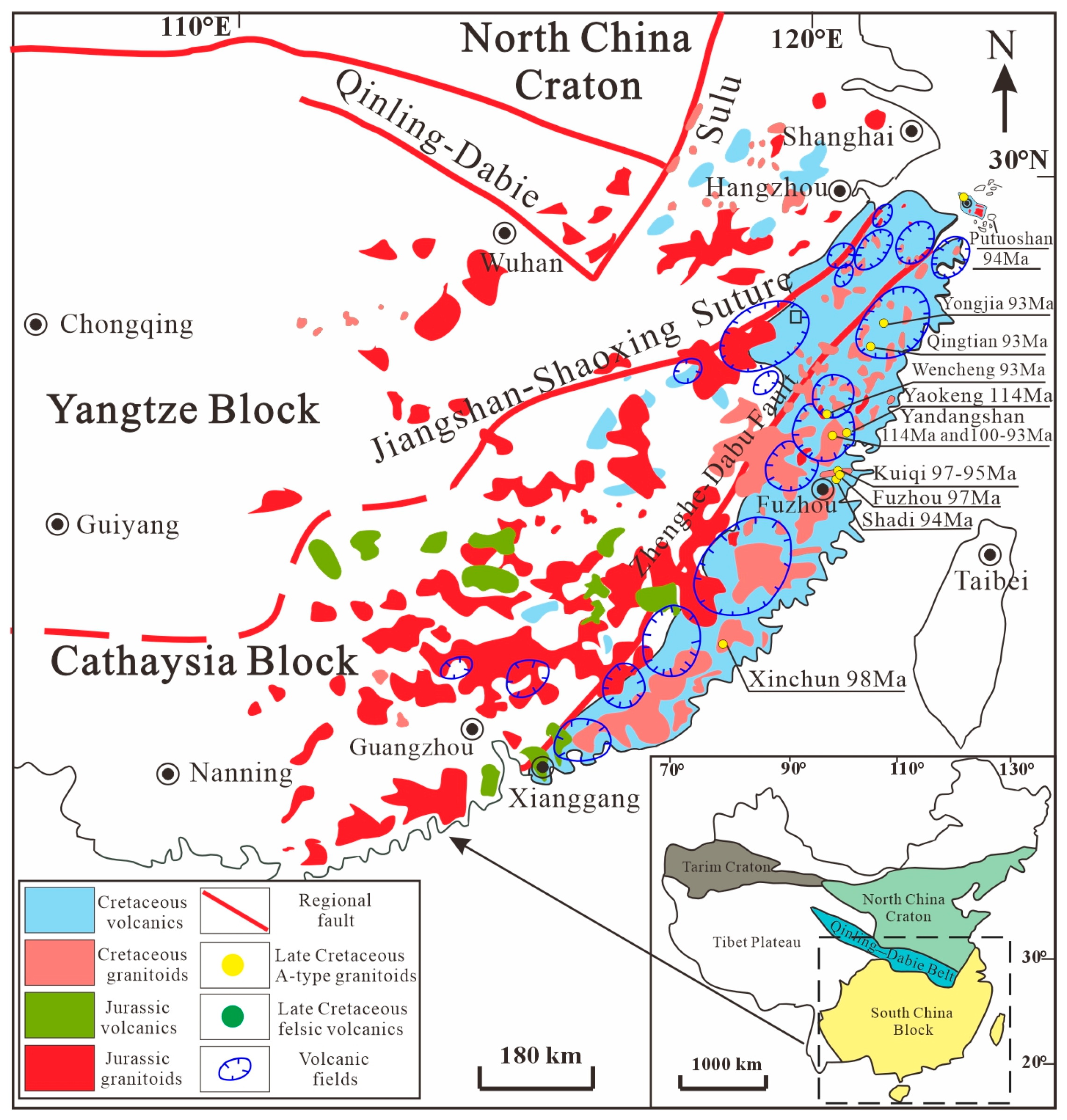
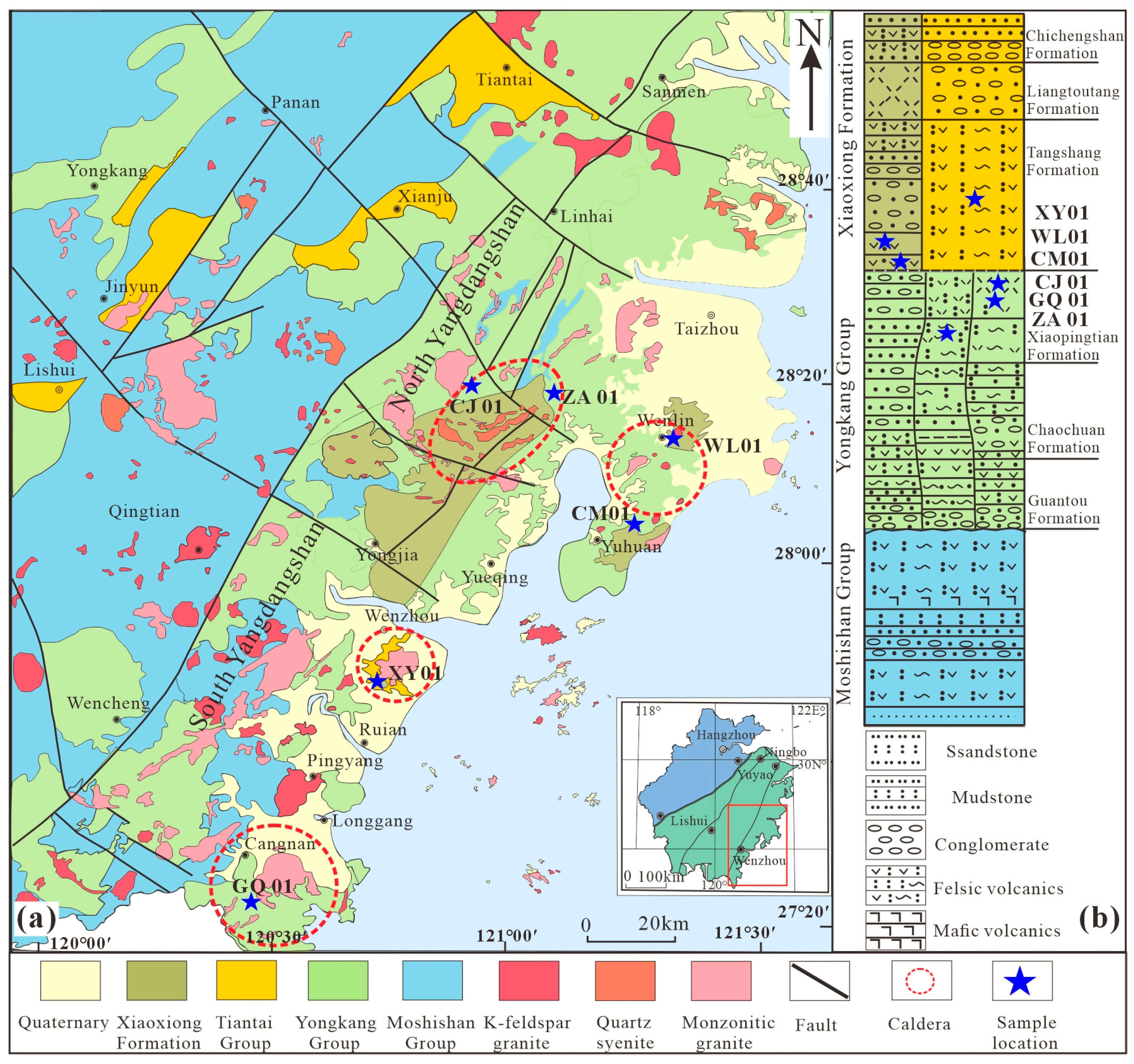


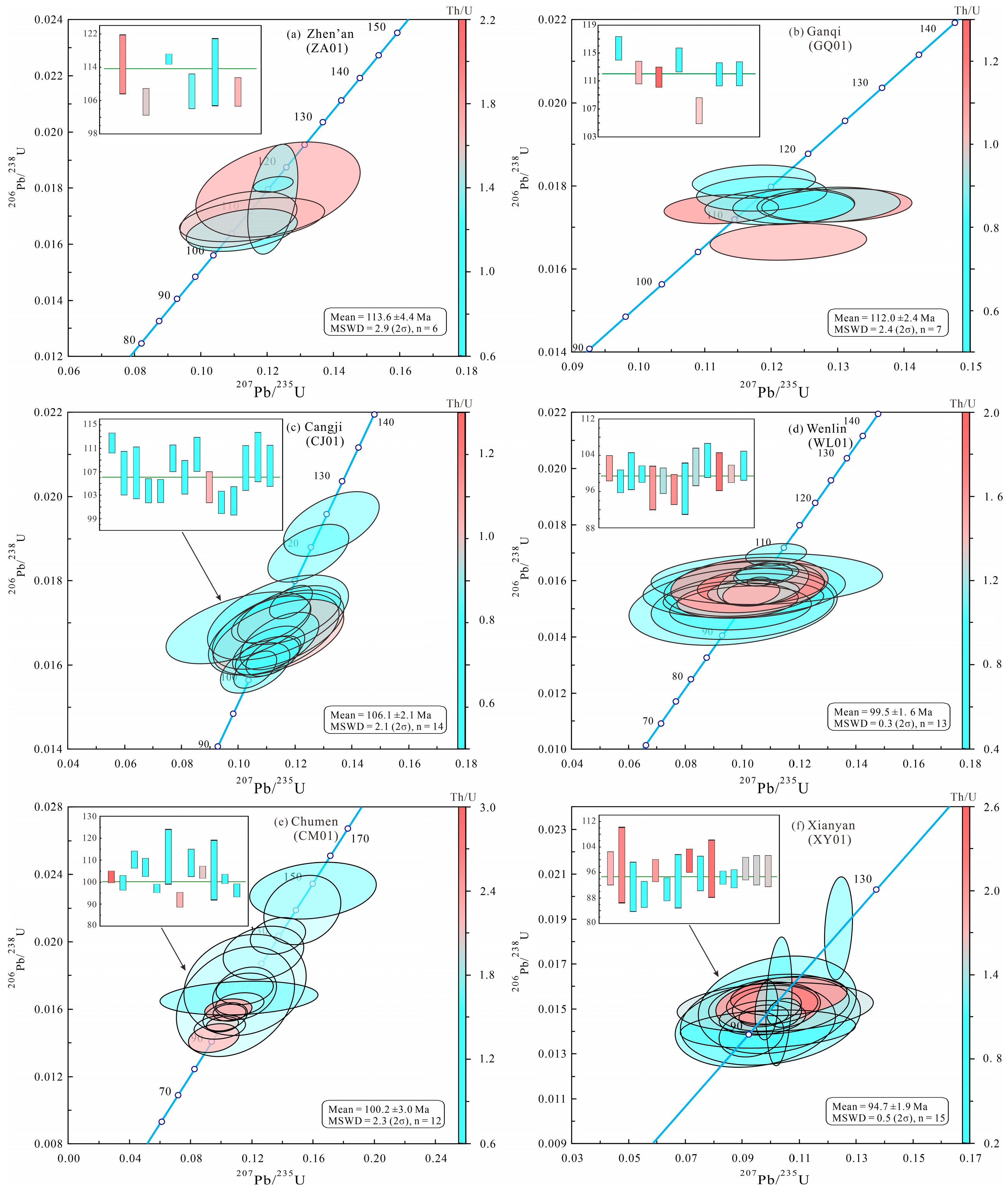
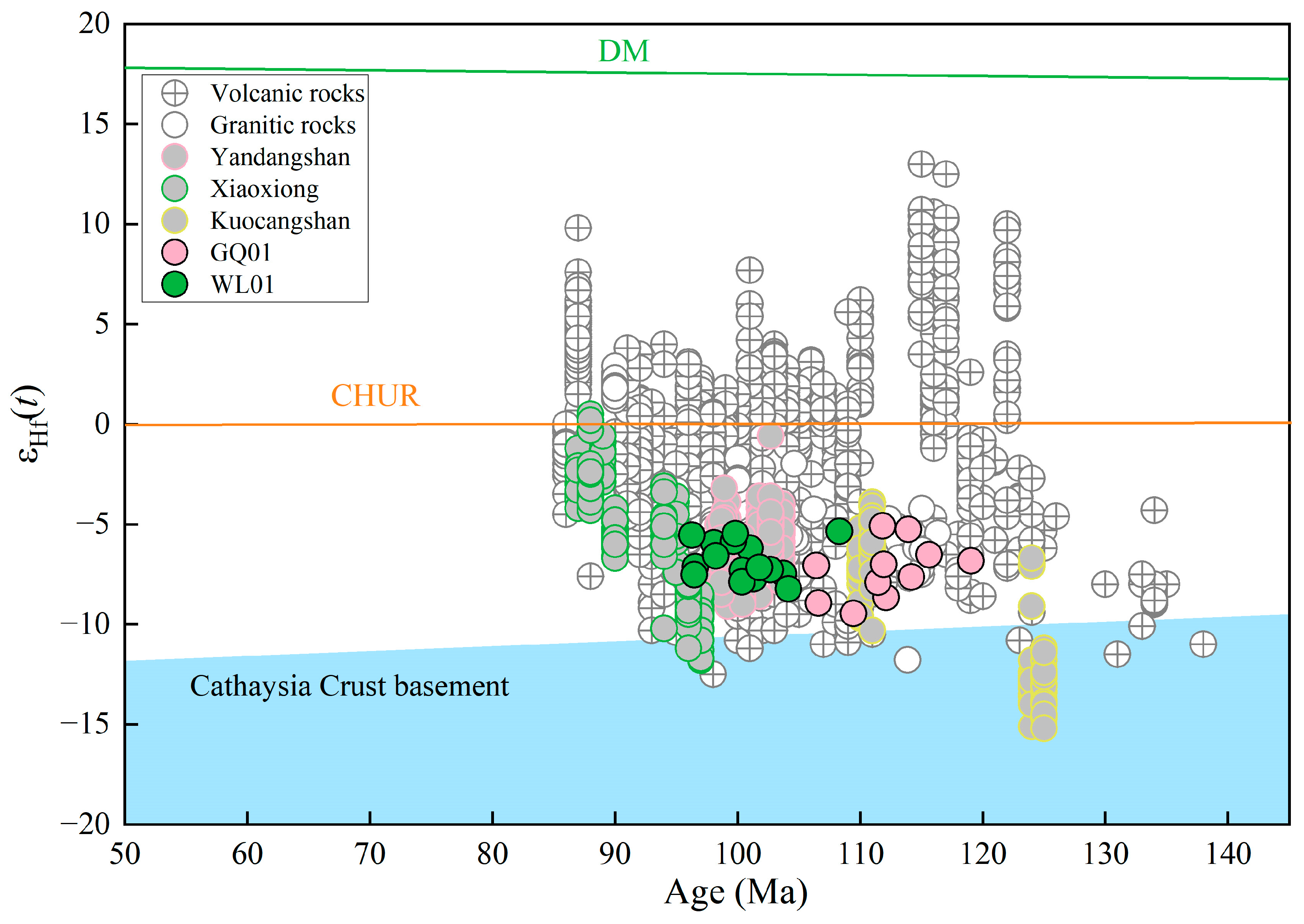
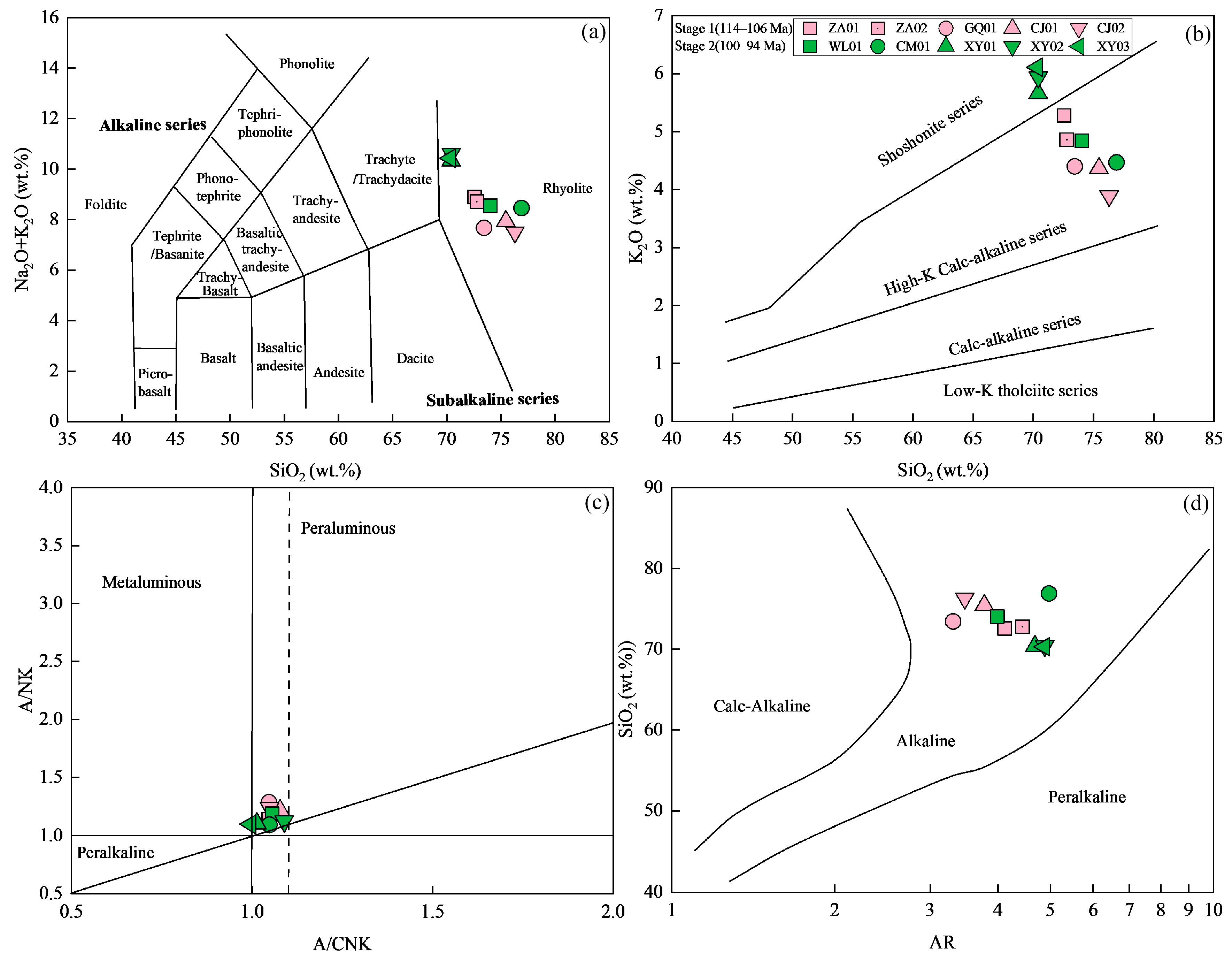
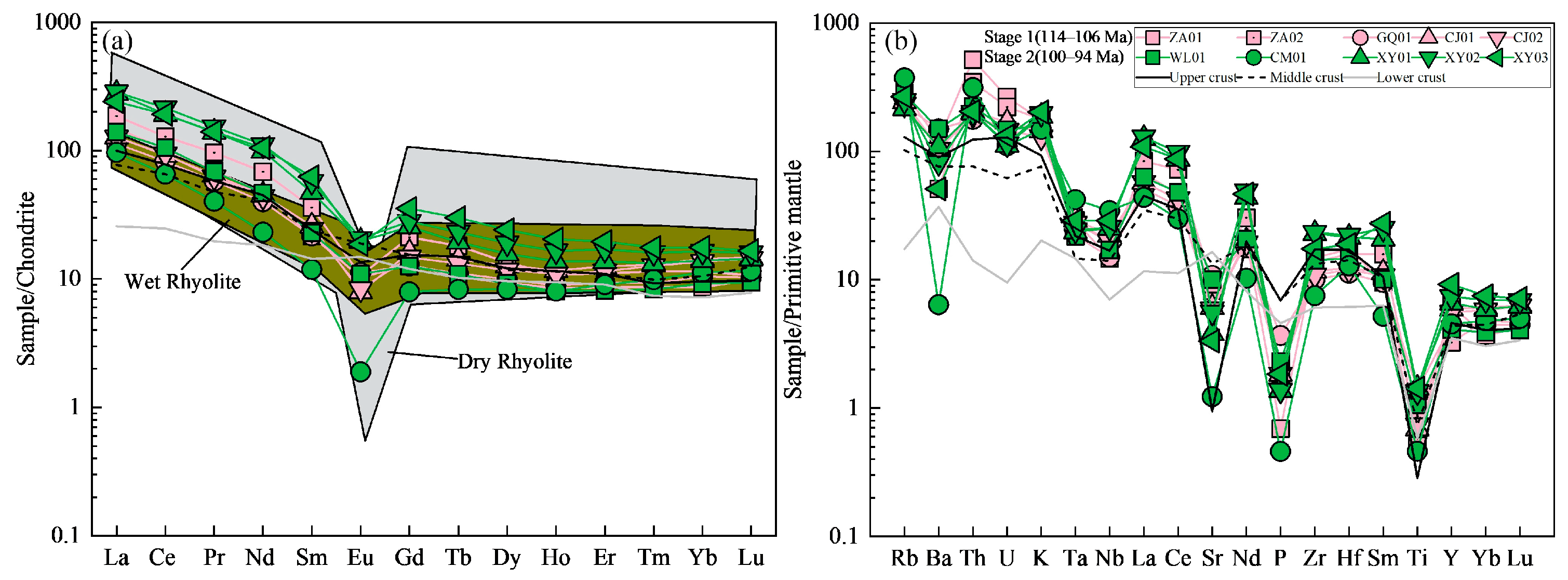
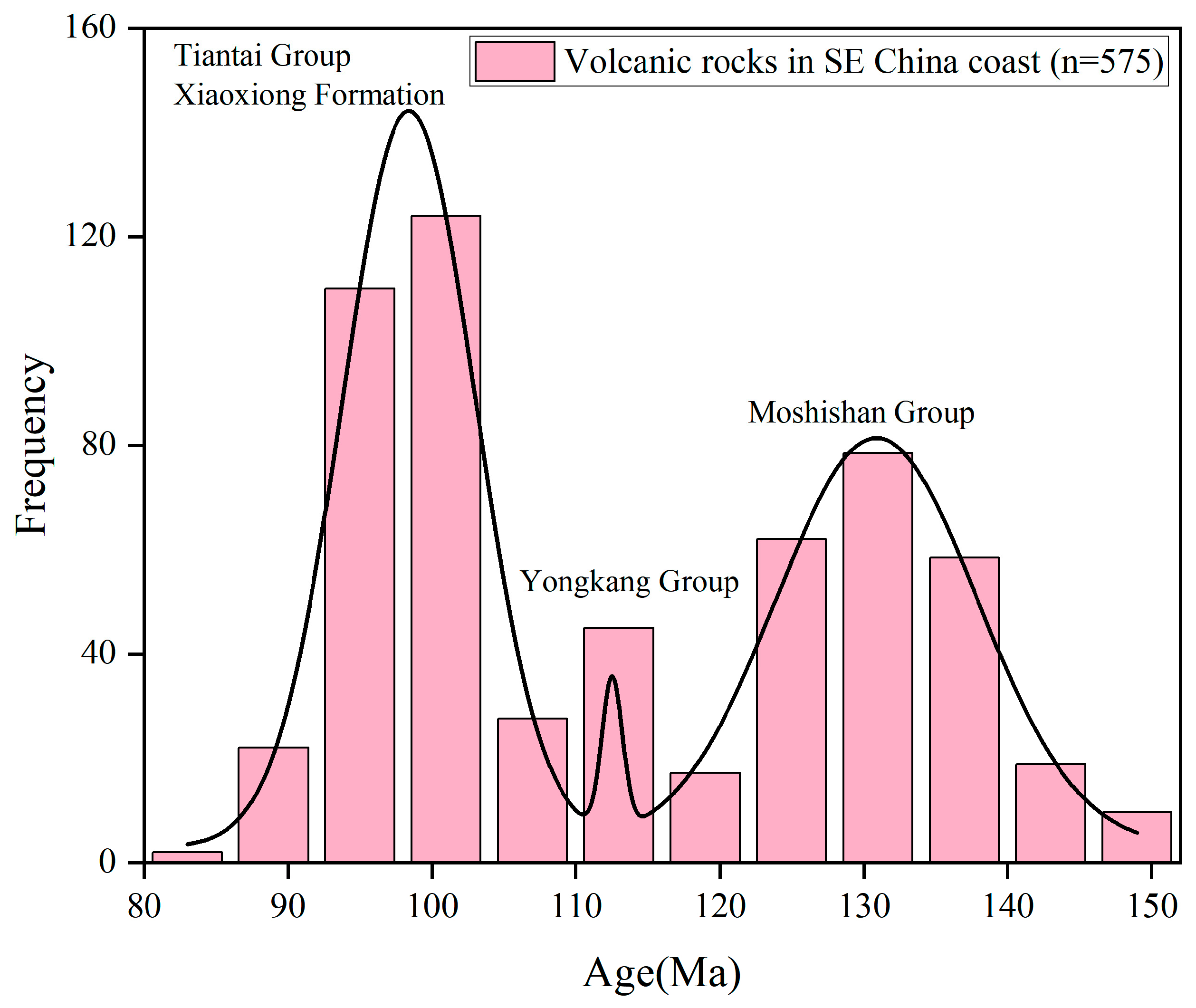

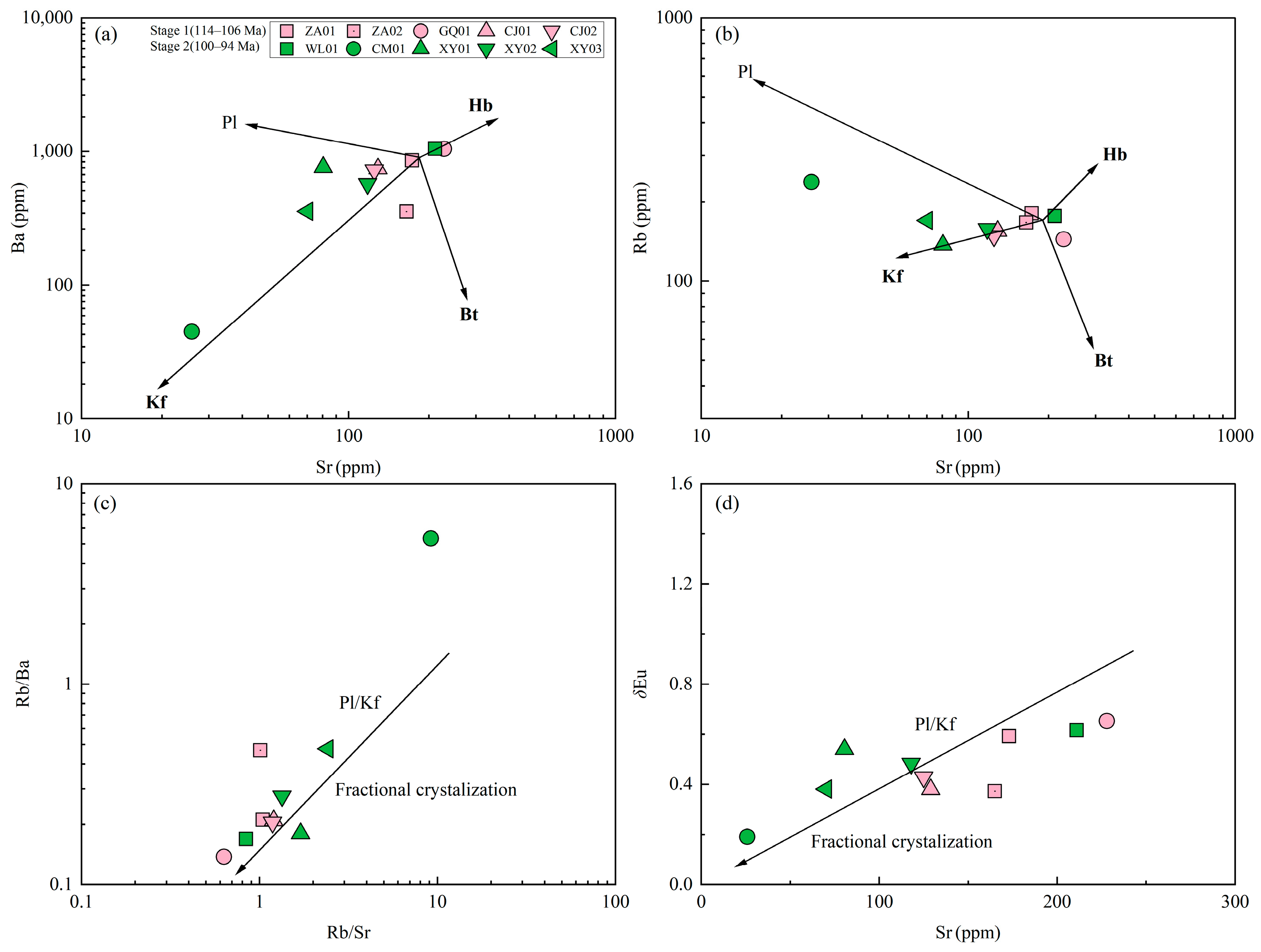
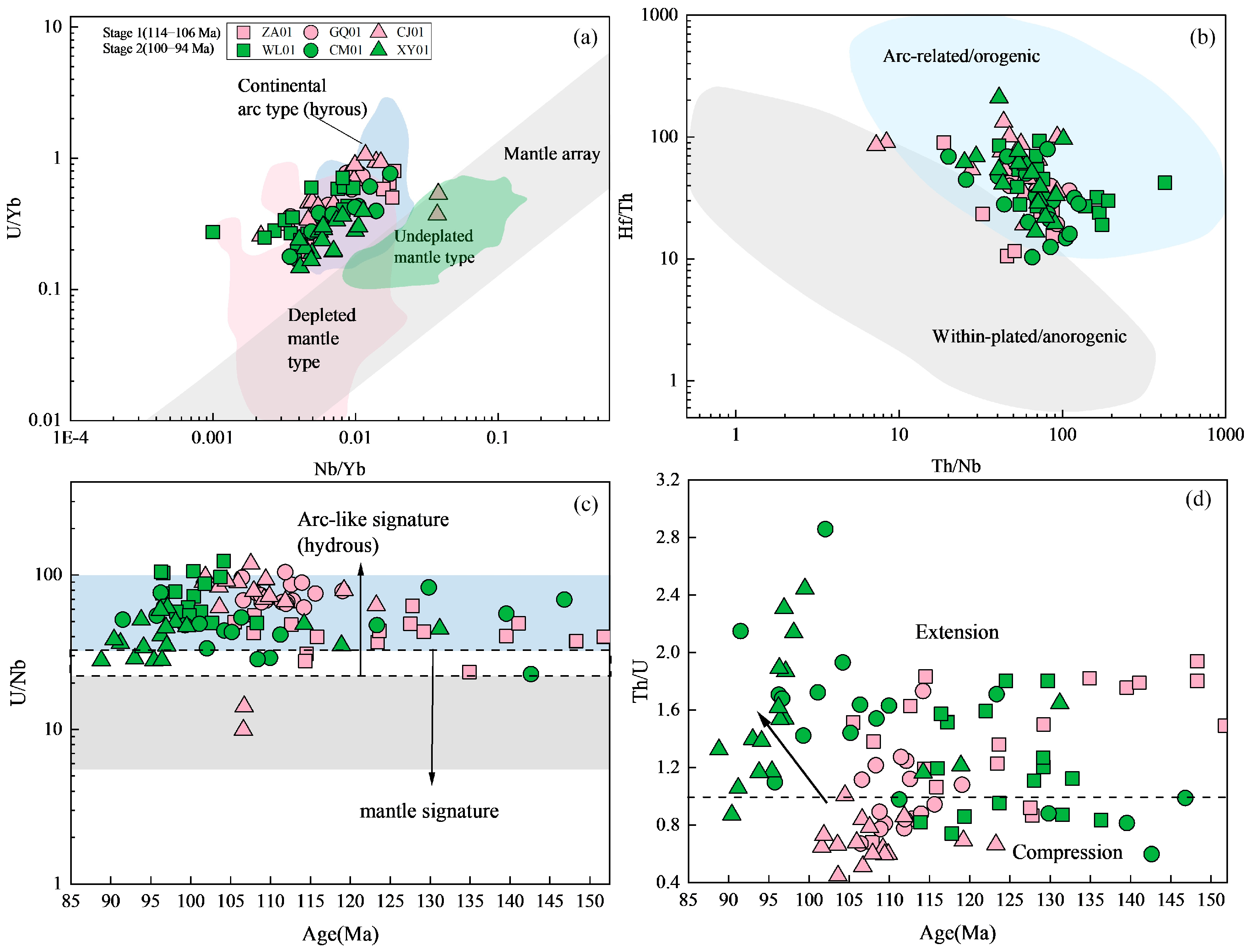


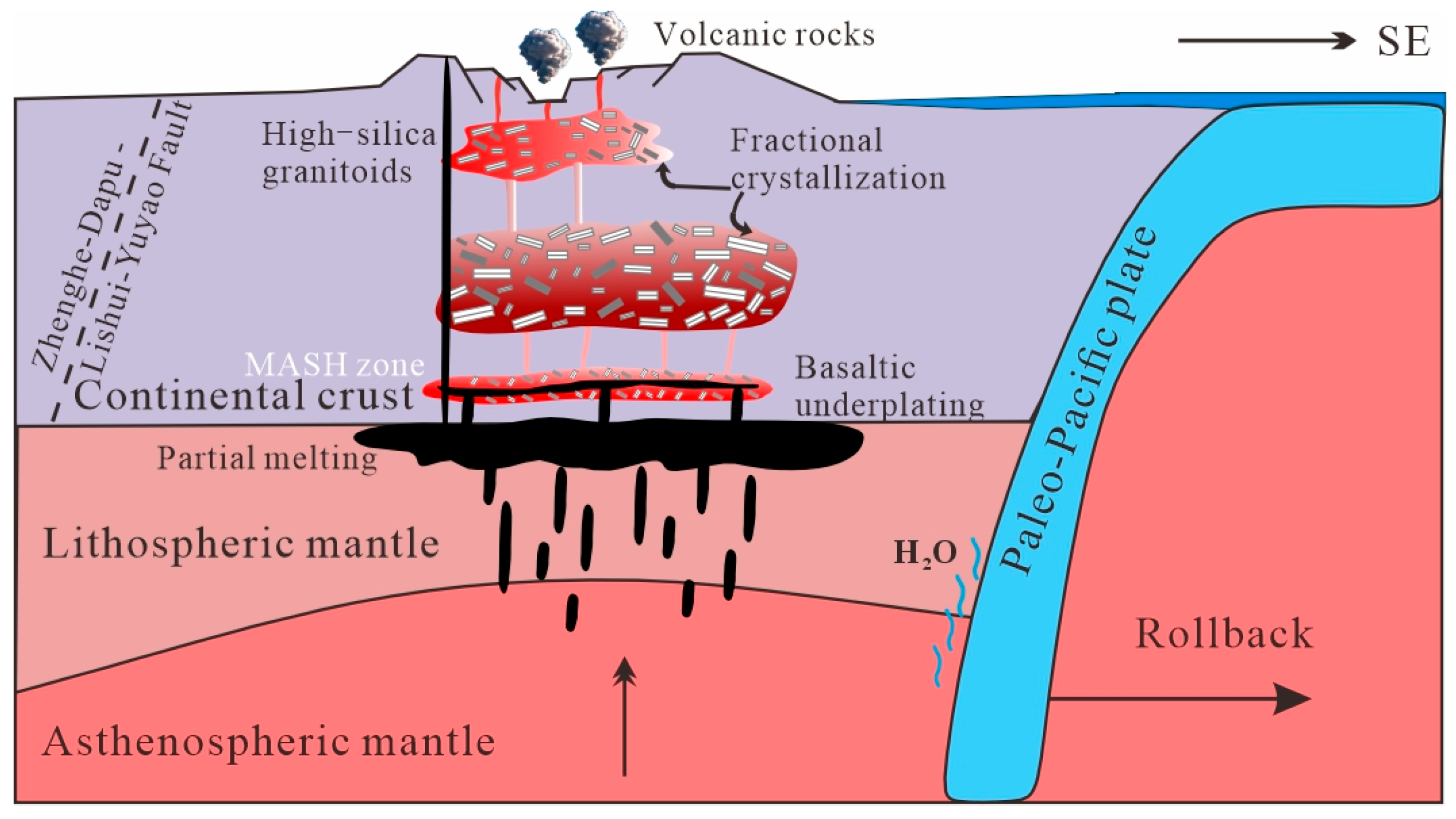
Disclaimer/Publisher’s Note: The statements, opinions and data contained in all publications are solely those of the individual author(s) and contributor(s) and not of MDPI and/or the editor(s). MDPI and/or the editor(s) disclaim responsibility for any injury to people or property resulting from any ideas, methods, instructions or products referred to in the content. |
© 2025 by the authors. Licensee MDPI, Basel, Switzerland. This article is an open access article distributed under the terms and conditions of the Creative Commons Attribution (CC BY) license (https://creativecommons.org/licenses/by/4.0/).
Share and Cite
Zeng, Z.; Tang, Z.; Siddique, U.; Wang, Y.; Liu, J.; Fu, B.; Li, Z. Chemistry of Zircon and Its Implication on the Petrogenesis of Cretaceous Volcanic Rocks from the Southeastern Coast of Zhejiang Province, South China. Minerals 2025, 15, 1147. https://doi.org/10.3390/min15111147
Zeng Z, Tang Z, Siddique U, Wang Y, Liu J, Fu B, Li Z. Chemistry of Zircon and Its Implication on the Petrogenesis of Cretaceous Volcanic Rocks from the Southeastern Coast of Zhejiang Province, South China. Minerals. 2025; 15(11):1147. https://doi.org/10.3390/min15111147
Chicago/Turabian StyleZeng, Zhijie, Zengcai Tang, Uzair Siddique, Yifan Wang, Jian Liu, Bingzhen Fu, and Zilong Li. 2025. "Chemistry of Zircon and Its Implication on the Petrogenesis of Cretaceous Volcanic Rocks from the Southeastern Coast of Zhejiang Province, South China" Minerals 15, no. 11: 1147. https://doi.org/10.3390/min15111147
APA StyleZeng, Z., Tang, Z., Siddique, U., Wang, Y., Liu, J., Fu, B., & Li, Z. (2025). Chemistry of Zircon and Its Implication on the Petrogenesis of Cretaceous Volcanic Rocks from the Southeastern Coast of Zhejiang Province, South China. Minerals, 15(11), 1147. https://doi.org/10.3390/min15111147






